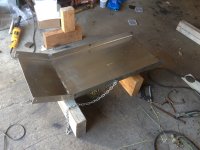I'd recommend designing/planning for at least 50 to make it worth the effort (both the build, and the time driving on and off the field to load/unload). If it's too heavy you can always back off.
I built a hitch and bale chute for my 24T and pull 16ft and 18ft "standard" hay wagons with 150-180 60lb bales on hilly ground with my IH B275 (38hp, ~3500lb tractor) with no trouble. You've got about 8 less HP and 1000lbs less weight, but I think you'd still have no problem pulling 100 bales on a wagon unless you're on hills.
I've used both kingpin (like cars) and center pivot (like radio flyer) front axle wagons - the center pivots usually have a tighter turning radius and are fairly well suited to make using a central I beam. Kingpin designs tend to wander (sometimes severely) at road speeds, but are easy to build using a 2wd truck or RWD car front axle in front and a FWD mini van axle for the rear.
Put some thought into bale size and stacking pattern when planning trailer width and lenth. 8ft wide fits 5 bales wide =|= first row, then alternating |== and ==| makes it easy to "interlock" stacks. If you only go 4 bales wide ( == then |||| then == ) can can get by with a narrower wagon, but it's easy to ;ose a whole corner, although if you're not stacking high it may not be a problem. Ideally you want enough room to stand in front of the front row to continue to pull bales off the chute.
You may be able to pick up an old hay wagon frame that needs new beams and deck for much less $ than you can buy steel, spindles, hubs and wheels for. 4x6 fir beams would be plenty strong for a 12ft long wagon. Two of my wagons decks are made of 1/2" plywood on top of 2x6's laid flat on 2ft centers, the other wagon is decked with 2x10 fir. 2x decking is overkill for a lighter weight wagon. 1" or 5/4" rough sawn is perfect for decking and less slipery. through-bolt a 2x4 on top around the perimeter to stiffen up the ends, which also helps keep people and bales from sliding off.
You also want the frame to be able to flex (twist) so all the wheels stay on the ground as you drive over dips and bumps.
The trailer tongue/baler hitch and bale chute need to be long enough to allow the bales to ramp up without kinking out the back of the baler, and the chute needs to be high enough (and short of the wagon) so that it doesn't crash into the corner of the wagon during turns... I've bent mine and ripped off the front of my decking a few times (left hand turn through a dip each time...) Finally extended the tongue on the one one problem wagon to prevent it from happening again... and learned to not turn left!
I can post some pics of my "train" and details of how I built the hitch frame and chute for the baler if you want... oh, and picks of the wagons, too!
-Pete
Bellingham, WA


